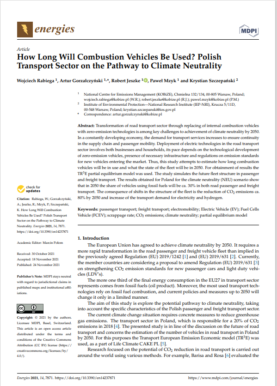New article “How Long Will Combustion Vehicles Be Used in the Polish Transport Sector on the Pathway to Climate Neutrality?”
We reccomend you to read “How Long Will Combustion Vehicles Be Used in the Polish Transport Sector on the Pathway to Climate Neutrality?“, which was published on the 24 November 2021 at Energies 2021 (Special Issue Trends in the Development of Electric Vehicle).
 Transformation of road transport sector through replacing of internal combustion vehicles with zero-emission technologies is among key challenges to achievement of climate neutrality by 2050.
Transformation of road transport sector through replacing of internal combustion vehicles with zero-emission technologies is among key challenges to achievement of climate neutrality by 2050.
In a constantly developing economy, the demand for transport services increases to ensure continuity in the supply chain and passenger mobility. Deployment of electric technologies in the road transport sector involves both businesses and households, its pace depends on the technological development of zero-emission vehicles, presence of necessary infrastructure and regulations on emission standards for new vehicles entering the market.
This study attempts to estimate how long combustion vehicles will be in use and what the state of the fleet will be in 2050. For obtainment of results the TR3E partial equilibrium model was used.
The study simulates the future fleet structure in passenger and freight transport. The results obtained for Poland for the climate neutrality (NEU) scenario show that in 2050 the share of vehicles using fossil fuels will be ca. 30% in both road passenger and freight transport.
The consequence of shifts in the structure of the fleet is the reduction of CO2 emissions ca. 80% by 2050 and increase of the transport demand for electricity and hydrogen.
- The full article is available here: https://doi.org/10.3390/en14237871
The article was prepared within the Centre for Climate and Policy Analysis (CAKE) set up in the National Centre for Emission Management (KOBiZE), which is a part of the Institute of Environmental Protection—National Research Institute (IEP-NRI). It was prepared within the project: LIFE Climate CAKE PL – LIFE16 GIC/PL/000031, which is co-financed from the EU LIFE programme and from the funds of the National Fund for Environmental Protection and Water Management.
Back
 Reset ustawień
Reset ustawień Kontrast
Kontrast Widok
Widok Czytelność
Czytelność Czcionka
Czcionka Znaki
Znaki Interlinia
Interlinia Słowa
Słowa Akapity
Akapity Deklaracja dostępności
Deklaracja dostępności









